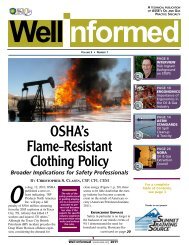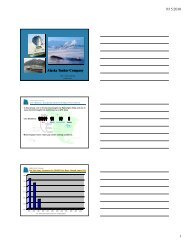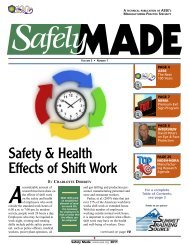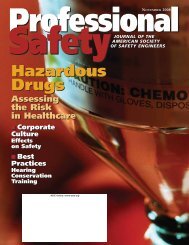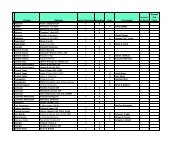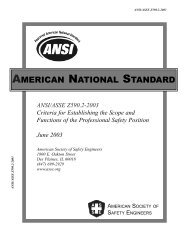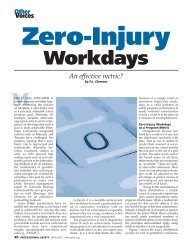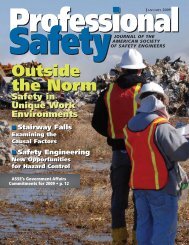Attendees atone <strong>of</strong> morethan 200educationsessions.PDCSponsors<strong>ASSE</strong> thanks the followingcompanies for theirsupport:•Behavioral ScienceTechnology Inc.•<strong>American</strong> HeartAssociation•ISHN•AON <strong>Safety</strong>LogicFoundation Thrivesat <strong>Safety</strong> <strong>2008</strong><strong>ASSE</strong> chapters and regions, individual members and organizationsmade monetary donations, totaling more than $226,000,to the <strong>ASSE</strong> Foundation to help support education and researchin the SH&E field. In addition, the Foundation’s silent auctionraised nearly $9,500, while the golf outing raised more than$16,000. To see a complete list <strong>of</strong> donations made during <strong>Safety</strong><strong>2008</strong>, visit www.asse.org/societyupdate/0807-foundation.php.Seabrook agrees thatthe educational opportunitiesset the conferenceapart. “The conferenceprovides the best, mostfocused pr<strong>of</strong>essional-leveldevelopment for industrialsafety practitioners.”And, like Thompson, shepoints to the impact <strong>of</strong> the growing internationalcontingent. “This provides U.S.-based pr<strong>of</strong>essionalswith the opportunity to benchmark best practiceswith our counterparts around the globe.”Garlapati also lauds the increased diversity atthe conference, pointing in particular to the internationallounge. “The concept <strong>of</strong> the lounge is uniqueto <strong>ASSE</strong> and it has helped me interact with peoplefrom places like Singapore, Nigeria, India, the U.K.and Australia.”Hearing from business speakers such as RobertCialdini and a panel <strong>of</strong> corporate executives (see“Executive Summit” sidebar below) was anotherimportant factor for many. During his general sessionpresentation, Cialdini told attendees that tomove people in your direction you must “do morethan give them information. You have to mobilizepeople to interact with and employ that information.”He also noted that people are “mobilized bythe idea <strong>of</strong> losing something. Besides telling peoplewhat they will gain, explain what they will lose ifthey don’t take a certain action.” Cialdini’s messageresonated with attendees, many <strong>of</strong> whom lined upto have him sign a copy <strong>of</strong> his book.For some, gaining new perspectives was a realplus. Linda Rhodes, CSP, appreciated the insightsshared during a presentation on the conflictsbetween safety and production. “The speaker thoroughlyexplained why safety pr<strong>of</strong>essionals mustunderstand that safety strategies cannot succeed ifthey exist just for safety’s sake,” explains Rhodes,general manager <strong>of</strong> system safety for the ChicagoTransit Authority. “Understanding how productionenvironments encourage risk-taking behavior is atopic I’ve heard numerous times, but this presentationwas done better than others I’ve seen.”Comprehensive coverage was a key takeawayfor Steve Minshall, CSP, CIH, CHMM, director,health and safety, Ash Grove Cement Co. “I thoroughlyenjoyed the 3-day seminar on corporatesafety management and the opportunity to experiencethe breadth and depth <strong>of</strong> knowledge amongthe other attendees.” Minshall says this points towhat distinguishes <strong>ASSE</strong>’s conference—“theamount <strong>of</strong> practical, usable information available—from the keynote speakers, the session speakersand the seminar instructors.”As Thompson sums it, “One attendee stoppedme to say, ‘No other conference is so comprehensiveand <strong>of</strong>fers access to so many subject-matterexperts. I will encourage others to choose this conference.’Clearly, attendees looked at <strong>Safety</strong> <strong>2008</strong> astime well spent.”Executive SummitThe leaders on hand for this year’sExecutive Summit agreed that safety is akey factor in how their companies are perceived—byemployees, the public andinvestors. Even one mistake can damage acompany’s reputation and make it difficultto compete. That, they said, is ahuge motivation to be sure safety istaken seriously.“<strong>Safety</strong> is not an <strong>of</strong>fshoot,” said LenRodman, chair and CEO <strong>of</strong> Black andVeatch Construction Co. “It’s what wedo. <strong>Safety</strong> and reliability to clients isintegral to our success.”That philosophy has to start at thetop, according to panelist Anil Mathur,CEO <strong>of</strong> Alaska Tanker Co. “It is ourresponsibility, corporate management,to set the safety mindset,” he noted,observing that for him, safety reallystarts with the individual. “You have tohave a personal passion for it and youhave to understand how important relationshipsare in making safety happen.”Business leaders also see the value<strong>of</strong> safety in employee retention. “If youdon’t provide a safe and healthy work environment,you will lose employees and it willbe harder to recruit employees,” said AlanFeldman, MGM Mirage senior vice president<strong>of</strong> public affairs. “This is bad for businesssince the cost <strong>of</strong> turnover is extremely high.”Customer service is another area affectedby safety—or lack <strong>of</strong> it. As Diane Wolf, vicepresident <strong>of</strong> shared services for Kraft Foods,[From left]: Executive Summit panelists Len Rodman, Black &Veatch Construction Co.; Diane Wolf, Kraft Foods; AlanFeldman, MGM Mirage; and Anil Mathur, Alaska Tanker Co.said, “You can’t deliver a quality product ifyou aren’t doing safety right.” Feldmanadded, “If you provide a safe work environment,employees are happier. For MGM,that translates into providing a greaterguest experience.”With respect to measuring safety, thepanelists mentioned the usual variety <strong>of</strong> leadingand lagging indicators, but Mathur cautionedattendees not to overanalyze. “Youcan measure and analyze everythingand understand nothing,”he said. “Too much analysis losesthe personal aspect. The mindsethas to be that this [lack <strong>of</strong> safety]is unacceptable.”To deliver the safety message,the panelists called onSH&E pr<strong>of</strong>essionals to continuetheir efforts to speak the language<strong>of</strong> business, know theiraudience and be creative. “Welook to you to take us beyondthe expected when it comes tosafety to explore and presentnew ways to increase workplacesafety in this day <strong>of</strong> globalization,”said Rodman. Mathur alsocalled on practitioners to keep itreal. “<strong>Safety</strong> pr<strong>of</strong>essionals shouldunderstand that the leader manages the corporatemindset. Influencing that mindsettakes authenticity.”40 PROFESSIONAL SAFETY AUGUST <strong>2008</strong> www.asse.org
BestPracticesEmployee Wellness ProgramsHow UPS Improved Productivity & Reduced InjuriesBySarah BloomHealth andwellnessbecame apersonalvalue withinthe culture<strong>of</strong> thefacility.PHOTOS ©<strong>2008</strong> UNITED PARCEL SERVICE. PRINTED WITH PERMISSION.Twice a week, Julia Carlson cycles to work at the Wellness From the Top DownUnited Parcel Service (UPS) Center in Petaluma, The 12-month program focuses on a differentCA, 17 miles from her home. Three days a week, topic each month to educate employees about allshe participates in a walking group with other driversbefore work, enjoying the scenery <strong>of</strong> a wildlife preservenot far from the center. Sometimes, she joins herfellow drivers for a yoga class. To cope with the stress<strong>of</strong> her physically and mentally demanding job, Carlsontakes advantage <strong>of</strong> the programs that UPS now <strong>of</strong>fersits employees to increase health awareness anddecrease workplace injuries and illnesses.Carlson’s is not an isolated case. Many UPS driversin Petaluma are participating in the company’snew wellness program,which <strong>of</strong>fers avast array <strong>of</strong> activities,classes and healthinformation to ensurelonger and healthierlives for employees.In 1995, UPS decidedto take a fresh lookat safety, personalinjuries and on-thejobaccidents. Thecompany found thatthe most commonwere back, shoulderand knee injuries.“We decided that thenumbers were goingin the wrong direction,” says UPS spokespersonDan McMackin.Deciding to take action against this unfavorabletrend, UPS launched the Comprehensive <strong>Safety</strong>and Health Process, and established health andsafety committees at 2,900 facilities across the country.The committees rely on nonmanagementemployees at each facility—“wellness champions”—tospearhead the program by promotingmonthly health topics and driving the activities. Atthe Petaluma facility, this is Carlson’s responsibility.Carlson has always been a healthy person. Infact, 2 years ago she was training to run a marathon.But, she says, as the wellness champion forher district, her interest in her own health is makinga greater impact on other people’s lives as theyfollow her example.Although drivers in Petaluma were initiallyapprehensive about it, the program has taken <strong>of</strong>fand generated huge amounts <strong>of</strong> enthusiasm abouthealth and safety.On the whole, UPS has seen a decrease in absenteeism,an increase in productivity and morale, anda 60% reduction in on-the-job injuries since the programwas first implemented.aspects <strong>of</strong> their health. For example, the topic forJuly is immunization awareness, August is healthand well-being and September is understandingcholesterol. UPS also publishes Road Map to Health, awellness guide for employees that provides detailedinformation about each month’s topic.In addition to the monthly topics, the wellnessprogram includes a wide variety <strong>of</strong> activities toimprove employee health including morning walking,yoga, prework stretching sessions, vendordemonstrations fromorganizations such asthe <strong>American</strong> HeartAssociation, healthfairs and informationalPowerPoints.According toMcMackin, the programemploys a“cafeteria approach,”<strong>of</strong>fering employees asmany options as possible,in hopes thatthey will try somethingand like it.On the corporatelevel, wellness programsare usuallyimplemented in an effort to keep employee healthcarecosts at bay by reducing doctor visits and loweringthe risk <strong>of</strong> long-term health problems.According to UPS Occupational Health ManagerMary Breen, who runs the program at the corporatelevel, the cost to put together the Roadmap to Healthand the monthly health topics was about $8,000,and each facility has its own budget to create wellnessactivities for its employees. Breen says the programis worth every penny.Last year, UPS experienced a 7.5% inflation rateon its healthcare expenses. “Most companies are inthe double digits and we expect that number tokeep going down,” Breen says.Many health-oriented organizations and vendorswere willing to give informational presentationsand participate in health fairs for the program at littleor no cost.“I don’t think a day goes by that I don’t get positivefeedback [about the program],” Breen says.Because UPS is an operations-focused industry,there was a tendency to focus too much on numbersand customers. “We had to actively push safetyto the forefront,” McMackin says.Best Practices continued on page 42www.asse.org AUGUST <strong>2008</strong> PROFESSIONAL SAFETY 41




